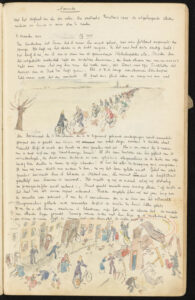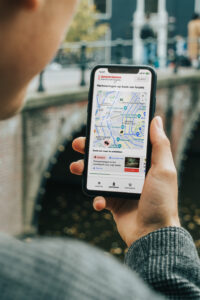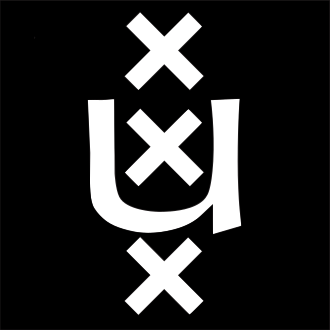The Amsterdam Time Machine collaborates with researchers from Amsterdam Diaries, a project led by Babs Boter (Free University Amsterdam) and Marleen Rensen (University of Amsterdam). This project aims to collect, study, and present personal stories on the city of Amsterdam throughout the centuries to a broad audience.
With an interdisciplinary research team, diaries are examined from the perspective of Amsterdam as a ‘world city.’ On one hand, the project focuses on the stories of migrants, exiles, and refugees who have settled in the city; on the other hand, it explores the ‘world’ in the daily lives of Amsterdam residents who have always lived in the Netherlands but write about world news, vacations, literature, music, fashion, or international cuisine.
focuses on the stories of migrants, exiles, and refugees who have settled in the city; on the other hand, it explores the ‘world’ in the daily lives of Amsterdam residents who have always lived in the Netherlands but write about world news, vacations, literature, music, fashion, or international cuisine.
As a first step in this project, we wanted to locate and inventorize as many diaries with a clear link to Amsterdam as we could find. We set out to focus on diaries from the 19th and 20th century with relatively many indications of place, people and time. If possible, our goal was to pay special attention to migrant diaries and diaries by (artist) women.
Since September, four students have been actively locating useful diaries in various archives, such as the IISG, the Jewish Museum, and the Amsterdam City Archives. This was a very meticulous task, where the students had to visit the reading rooms of the archives, request the manuscripts of the located diaries written in Amsterdam, browse through the diaries to judge the relevance of the contents and note down all relevant information.
Based on the resulting inventory, we decided to move forward with a selection of diaries that had already been digitized by the archives themselves, making it easier to refer to the original source and presenting our results as linked data. These digitized diaries often proved to be written in the first half of the 20th century, with a majority of war diaries from the Second World War.
The major challenge now is to transition from the digital version of these diaries to linked data. This is currently done through the following process:
- Metadata – Metadata is added to the digital material, with permalinks to the original archival sources.
- Transcription – The digitized scans of the diaries are uploaded in Transkribus, which automatically provides a transcription of the hand-written diary text. The student-assistants check and correct these transcription for all relevant passages on Amsterdam.
- Tags – In Transkribus, text passages are then tagged. Tags include: people, places, dates, and organisations.
- Export – In the final step, the tagged diary fragments are exported from Transkribus, and links to authoritative databases (Wikidata, Adamlink) are added.
Based on the d esigns Rosan Gleijsteen made as part of her graduation project, Total Design is developing a mobile application that combines digitized diaries, archival documents, historical images, and addresses. The user can select a period using a timeslider, and all available content is displayed on a corresponding historical map. Where possible, images from historical image collections are added. This application will be ready in time for the 750th anniversary of Amsterdam and will ideally serve as an interactive platform for even more Amsterdam memories.
esigns Rosan Gleijsteen made as part of her graduation project, Total Design is developing a mobile application that combines digitized diaries, archival documents, historical images, and addresses. The user can select a period using a timeslider, and all available content is displayed on a corresponding historical map. Where possible, images from historical image collections are added. This application will be ready in time for the 750th anniversary of Amsterdam and will ideally serve as an interactive platform for even more Amsterdam memories.
The creation of the application is made possible by the support of the Dutch Digital Heritage Network (NDE).

